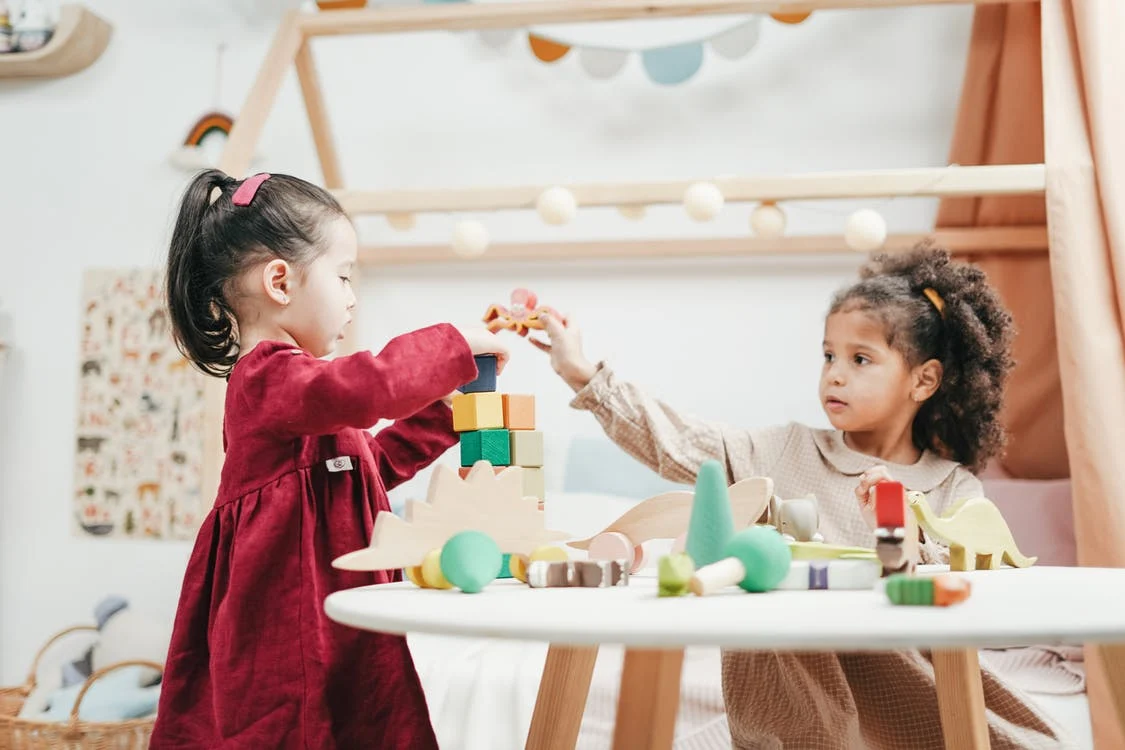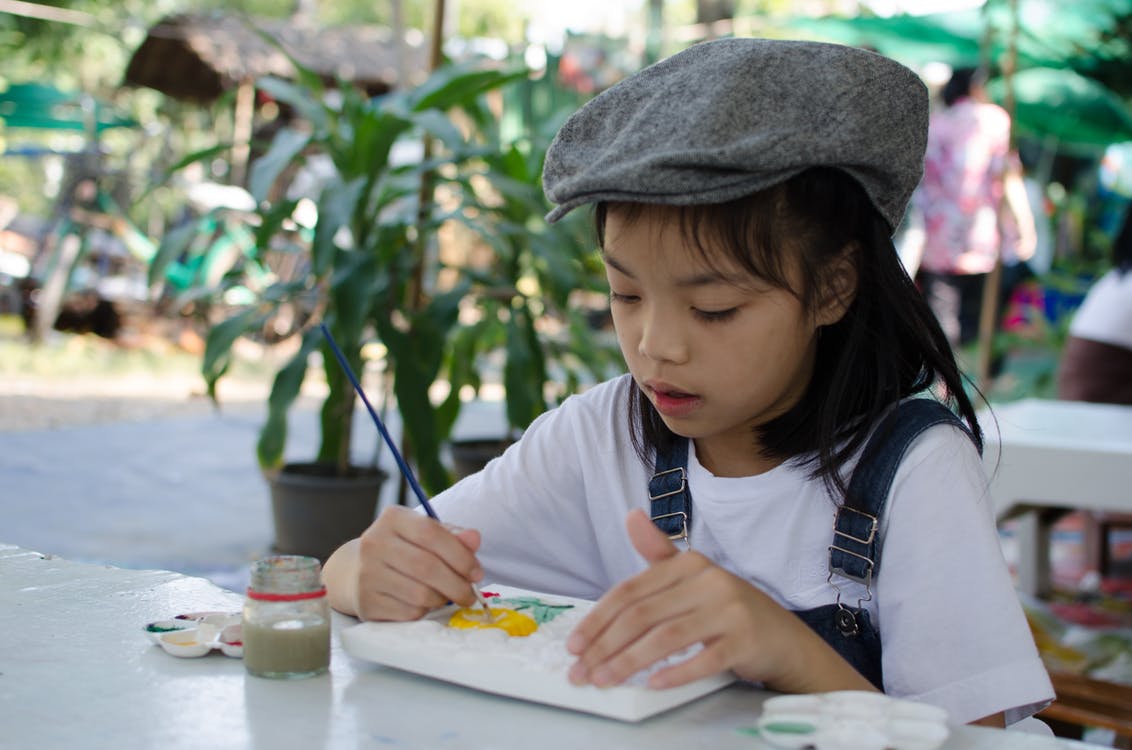Exploring Abstract Art With Children
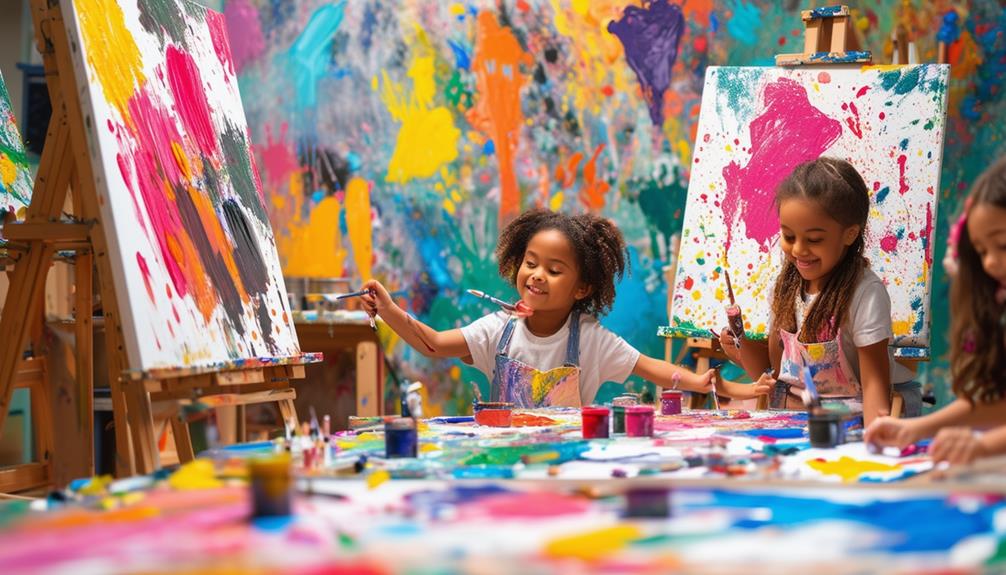
Introducing children to abstract art opens up a boundless realm of creativity. Simple activities like finger painting and blending watercolors allow them to explore colors, shapes, and textures in unique ways that traditional art forms may not offer. This not only encourages personal expression but also aids in understanding and communicating emotions. Imagine how a child's perspective shifts when they learn about artists like Wassily Kandinsky and Joan Miró. How do you start this exploration, and what key benefits will you encounter along the way?
Understanding Abstract Art
Understanding abstract art begins with recognizing that it emphasizes shapes, colors, forms, and textures over realistic representation. Instead of depicting exact images of people, objects, or landscapes, abstract art uses these elements to express emotions or ideas. Introducing young children to abstract art allows them to explore these concepts in a fun and engaging way.
Children naturally gravitate towards shapes, making abstract art especially appealing to them. They can experiment with circles, squares, triangles, and diverse irregular forms, allowing their imaginations to run wild. Artists like Wassily Kandinsky, known for his geometric abstraction, often use interesting shapes and lines that capture children's attention and spark their curiosity.
Benefits of Art for Kids
Introducing kids to art offers numerous developmental advantages that extend beyond simple creative expression. Engaging in art activities helps children build fine motor skills and muscle memory, essential for tasks like writing. Art also enriches cognitive abilities by fostering problem-solving and critical thinking.
Abstract art, in particular, stimulates creativity and imagination. It allows children to explore different ideas and perspectives without the pressure of creating something recognizable. This freedom can be incredibly liberating, fostering curiosity and open-mindedness.
Moreover, participating in art activities aids in communication and vocabulary development. When kids describe their artwork or discuss their creative process, they're practicing language skills and learning to articulate their thoughts. Art also helps in emotional identification, providing a safe space for children to express and understand their feelings.
Social-emotional health is another significant benefit. Art fosters a sense of accomplishment and enhances self-esteem. Through shared art experiences, kids learn to appreciate diverse viewpoints and develop empathy. By introducing your child to abstract art, you're not just nurturing their artistic abilities but also supporting their overall growth and development.
Overcoming Challenges
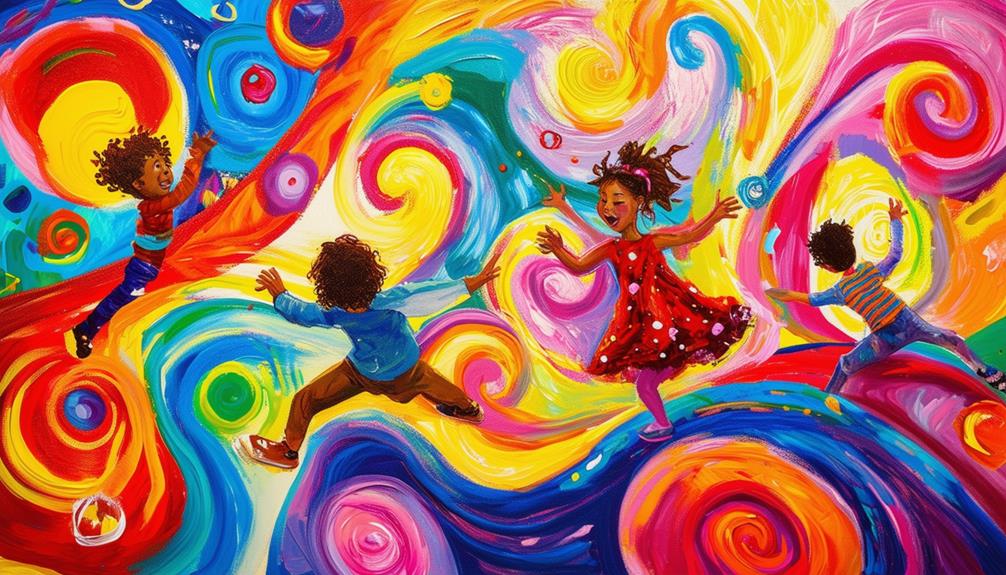
When exploring abstract art with children, you may face challenges like the absence of a defined end goal. Encourage them to embrace the unknown and view mistakes as opportunities to enhance their work. This approach helps them express themselves freely and develop their unique artistic style.
Embrace the Unknown
Embracing the unknown in abstract art involves releasing expectations and engaging with the creative process openly. For children, this approach can be particularly empowering. Abstract art's lack of a predefined end goal allows kids to explore and express their unique perspectives freely. The absence of rigid guidelines fosters a mindset of exploration and learning, crucial for their development.
Children often fear making mistakes, but abstract art redefines these 'mistakes' as potential highlights. By embracing the unknown, they learn to see challenges as opportunities for creativity rather than obstacles.
Abstract art also emphasizes self-expression through open-ended options. Instead of striving for perfection, children can paint until they're satisfied. This freedom creates a positive, stress-free environment where creativity thrives.
Turn Mistakes Positive
In abstract art, mistakes are not setbacks but opportunities for new creative possibilities. Embracing errors can lead to breakthroughs and unique outcomes, as abstract art thrives on experimentation and discovery. Encourage children to view mistakes as chances for growth and learning rather than obstacles.
Errors in abstract art can add depth, texture, and interest, enhancing the artwork's visual appeal. If a child makes an unintended mark or uses the wrong color, don't rush to correct it. Instead, guide them to explore how they can incorporate the mistake into their piece, transforming it into something beautiful and unexpected.
Abstract Art Activities
When introducing abstract art activities to children, begin with finger painting techniques to allow them to create unique textures using their hands. Experiment with watercolor blending to demonstrate how different hues interact. Encourage them to express their emotions through shapes and colors, fostering both creativity and fine motor skills.
Finger Painting Techniques
Finger drawing offers a hands-on approach for children to explore abstract art through tactile and sensory engagement. By using their fingers to create shapes and colors, kids can delve into the world of abstract art without limitations. This method encourages them to experiment with various patterns and textures while blending colors directly on the paper.
Finger drawing is not only fun but also beneficial for developing fine motor skills and hand-eye coordination. As children spread paint across the canvas, they improve their ability to control and synchronize their movements. This activity also fosters creativity, allowing them to express their emotions and ideas freely.
One of the best aspects of finger drawing is its simplicity and ease of preparation. With just some paper and non-toxic paint, you can set the stage for children's imaginations to run wild. Whether at home or in a classroom, this activity is accessible and enjoyable for children of all ages.
Watercolor Color Blending
Watercolor color blending allows children to explore the interaction between different shades directly on paper, creating unique and vibrant abstract art pieces. This hands-on approach to color theory makes the learning process exciting and fosters creativity and imagination.
To get started, you'll need watercolor paper, a basic set of watercolors, and brushes. Encourage children to experiment by blending warm and cool colors to see the stunning effects they can achieve. This activity not only teaches color theory but also helps develop fine motor skills.
Here's a simple guide to get you started:
| Activity | Description |
|---|---|
| Basic Mixing | Combine two colors directly on the paper to create new hues. |
| Gradient | Transition from dark to light by using more water for dilution. |
| Layering | Apply one color, let it dry, then add another layer. |
| Wet-on-Wet | Moisten the paper first, then add colors for soft blending. |
Watercolor color blending is a delightful way for kids to engage with abstract art, fostering a love for artistic expression and an understanding of how colors can transform their creations.
Shape and Color Expression
After mastering watercolor blending, children can further expand their artistic horizons by exploring abstract art. Abstract art allows kids to express emotions and ideas using various shapes and colors. Through experimentation, they learn to convey feelings and thoughts, sparking creativity and imagination.
Encourage your child to explore different shapes and colors, guiding them to understand how each combination can evoke different emotions. For instance, bold, angular shapes paired with bright colors might represent excitement or joy, while soft, rounded shapes in muted tones could convey calmness or sadness.
These activities are not only fun but also help develop fine motor skills and cognitive abilities. Manipulating shapes and colors enhances hand-eye coordination and problem-solving skills.
Provide materials like colored paper, markers, and paints to inspire their creativity. Encourage them to mix and match, creating unique and personal pieces of art. Abstract art offers a platform for free experimentation, fostering self-expression and imaginative thinking.
Layered Painting Techniques

Exploring layered painting techniques with children allows them to create depth and texture in their abstract art. By applying paint in multiple layers, kids can observe unique color combinations and patterns as each layer dries. This process enriches their artworks and teaches patience and the importance of letting each layer set before adding the next one.
Encourage children to use warm and cool color families separately to elevate the visual impact of their paintings. For instance, they could use reds, oranges, and yellows in one layer, and blues, greens, and purples in another. This separation makes the colors more vivid and prevents them from becoming muddy.
Emphasize the use of white and gray as neutral colors. These can be added between more vibrant layers to balance the composition and give the artwork a cohesive feel. Remind the kids to avoid overlapping colors within the same layer to prevent undesired color mixing effects.
Exploring Mixed Media
Building on the excitement of layered painting, mixed media invites children to incorporate diverse materials into their abstract creations, adding depth and texture. Mixed media in abstract art involves combining elements like paint, paper, fabric, and found objects, allowing young artists to experiment with textures, colors, and techniques.
To get started with mixed media, you can:
- Gather Materials: Collect items such as magazines for collaging, fabric scraps, buttons, and natural elements like leaves or twigs.
- Plan a Composition: Guide your child to think about how the various materials can be layered and arranged to create a cohesive abstract piece.
- Explore Techniques: Encourage your child to try methods like gluing, sewing, or layering paint over collaged elements.
Using mixed media, children can create depth and unique visual effects in their artwork. Collage, a popular form of mixed media, inspires creativity by allowing kids to assemble different materials into one piece. This approach offers endless possibilities for self-expression and artistic exploration, letting children push the boundaries of traditional art forms. By combining multiple materials, they can achieve a richer, more textured look in their abstract art, making each piece truly one-of-a-kind.
Famous Abstract Artists
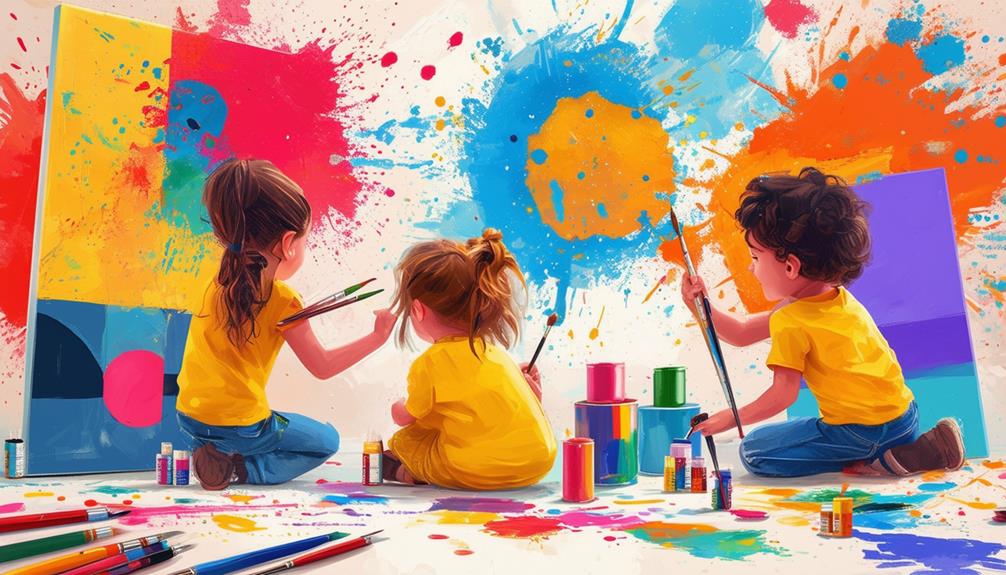
Many renowned artists have greatly influenced the world of abstract art, each bringing unique styles and techniques to the forefront. Wassily Kandinsky, often considered the pioneer of abstract art, used shapes, lines, and vibrant colors to create mesmerizing abstract paintings that encourage viewers to explore emotions and ideas beyond literal representation.
Joan Miró's abstract art is a playground of fanciful shapes and symbols, often inspired by dreams and the subconscious mind. His use of colorful, playful elements captures the imagination and invites diverse interpretations.
Piet Mondrian is another key figure in abstract art, known for his geometric compositions. He used primary colors and straight lines to create balanced grids, emphasizing harmony and simplicity. Mondrian's work illustrates the beauty of structure and order in abstract art.
Jackson Pollock took abstract art to new heights with his revolutionary drip painting technique. Emphasizing spontaneous movement and expression, Pollock's large canvases burst with energy and emotion, showcasing the dynamic potential of abstract art.
Mark Rothko, famous for his large color field paintings, used soft, blurred edges and overlapping colors to evoke deep emotional responses. His works demonstrate how abstract art can convey powerful feelings through simple color combinations.
Displaying Children's Art
Displaying children's art at home is a wonderful way to nurture their creativity and boost their confidence. Showcasing their masterpieces not only elevates their self-esteem but also makes them feel valued. Creating a gallery wall in your home can be an excellent method to display their evolving talents and encourage ongoing artistic expression.
Here are a few tips to effectively incorporate their art into your home decor:
- Create a Rotating Gallery: Dedicate a specific wall or space where you can easily switch out artwork. This keeps the display fresh and shows that you appreciate all their creations.
- Use Frames or Clipboards: Presenting their art in frames or on clipboards gives it a professional look and makes it easy to change pieces as new ones are created.
- Encourage Art Discussions: Take time to talk about the displayed art. Ask them to explain their work, which helps them articulate their thoughts and feelings.
Displaying children's art prominently fosters a sense of pride and accomplishment, serves as a delightful conversation starter, and promotes family bonding through a shared appreciation of their artistic journey.

